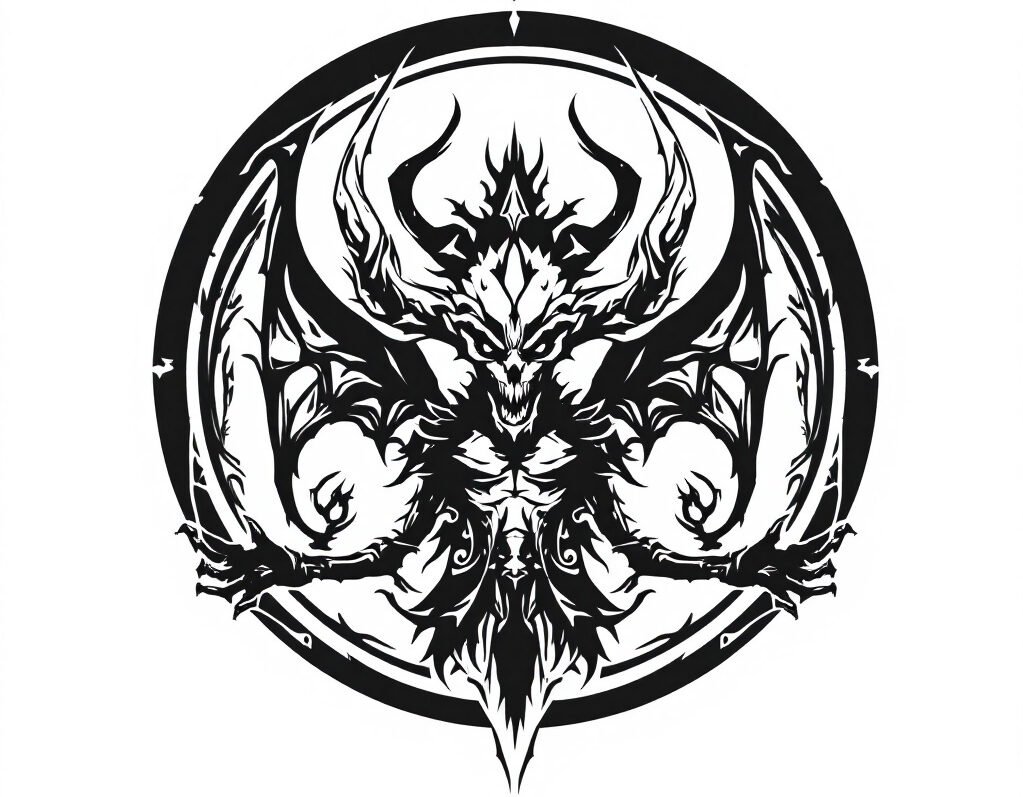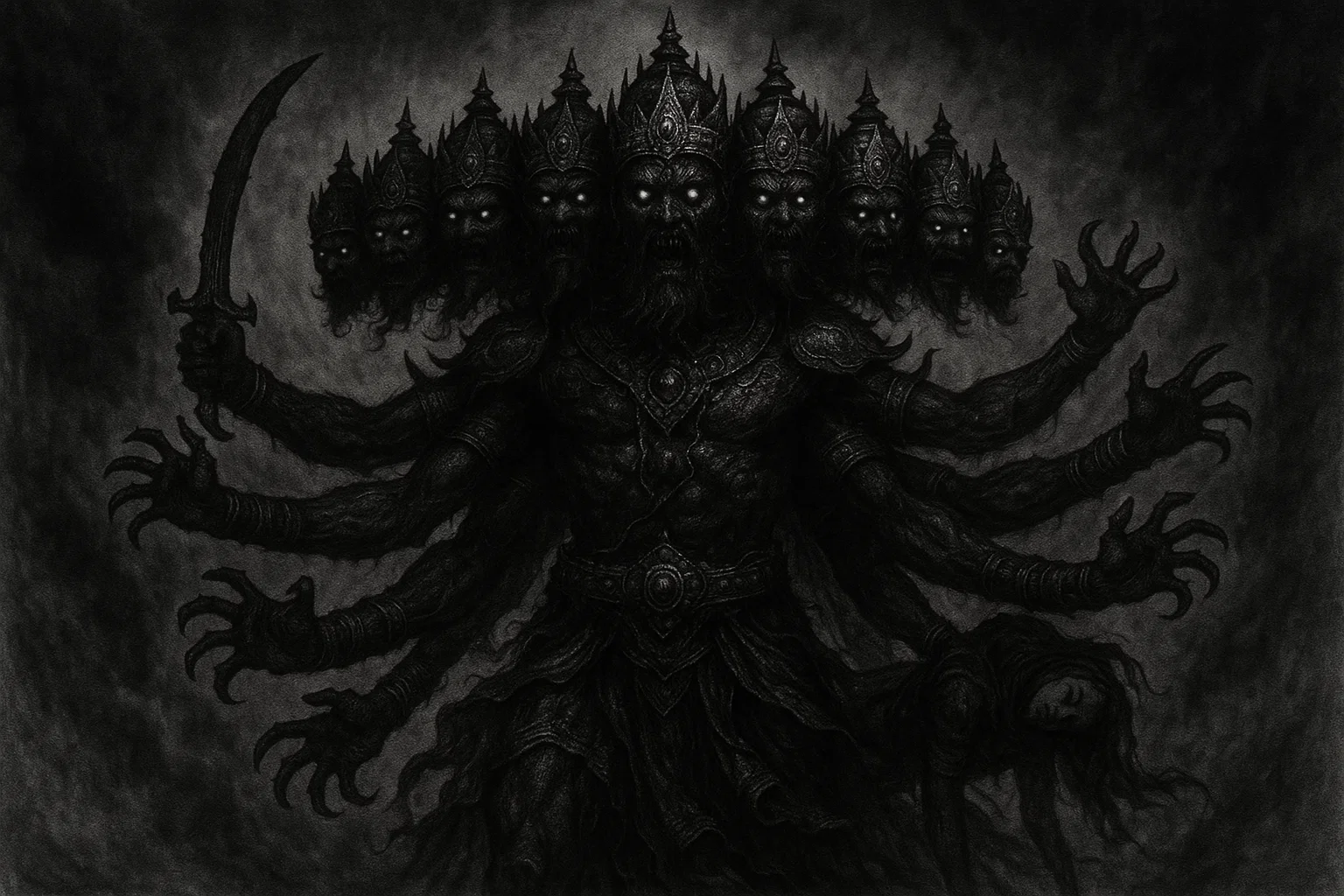Ravana, a well-known entity in Hindu mythology, is the formidable Asura king of Lanka in the epic Ramayana. Known for his ten heads, immense strength, and complex character, he is a central antagonist who embodies both villainy and scholarly brilliance.
As a Rakshasa leader, Ravana’s tale weaves through conquest, devotion, and tragedy, making him one of the most compelling figures in Hindu lore. His story, primarily detailed in Valmiki’s Ramayana, showcases his role as a warrior, scholar, and devotee of Shiva, whose ambition and pride lead to his epic clash with Rama, an avatar of Vishnu.
Despite his villainous acts, such as abducting Sita, Ravana is not merely a demon but a multifaceted character with admirable traits, including his mastery of the Vedas and his musical skill on the veena.
Summary
Key Takeaways
| Attribute | Details |
|---|---|
| Names | Ravana, Dashagriva, Dashanana |
| Title | King of Lanka, Lord of Rakshasas |
| Gender | Male |
| Role | Conqueror, scholar, devotee of Shiva, antagonist |
| Clan | Rakshasa |
| Followers | Rakshasas, Asuras |
| Deva Rival | Rama (Vishnu’s avatar), Indra |
| Powers | Shape-shifting, near-invincibility (boon from Brahma), mastery of magic |
| Appearance | Ten heads, twenty arms, dark complexion, regal attire |
| Etymology | From Sanskrit “Rava” (to roar), meaning “the one who roars” |
| Associated Figures | Sita, Rama, Lakshmana, Hanuman, Vibhishana, Kumbhakarna |
| Weaknesses | Pride, vulnerability to Rama’s divine weapons |
| Opposing Deva/Avatar | Rama, Vishnu |
| Pantheon | Hindu, with Vedic and Puranic influences |
| Element | Fire |
| Planet/Zodiac | Mars, Aries |
| Color(s) | Red, gold |
| Number(s) | 10 (for his heads) |
| Crystal/Mineral | Ruby |
| Primary Sources | Ramayana, Vishnu Purana, Shiva Purana |
“Ravana” Meaning
The term “Ravana” derives from the Sanskrit root “Rava,” meaning “to roar” or “to cry out,” reflecting his commanding and fearsome presence. So, Ravana’s meaning highlights his role as a powerful figure whose voice and actions resonate throughout the Ramayana.
His alternate names, such as Dashagriva (“ten-throated”) and Dashanana (“ten-faced”), underline his iconic ten heads, symbolizing vast intellect and sensory dominance. These names consistently appear in texts like the Ramayana and the Vishnu Purana, accentuating his multifaceted nature as both a scholar and a warrior.
However, Ravana’s definition extends beyond his name to encapsulate his identity as the king of Lanka and a Rakshasa leader. For example, in the Vedic and Puranic traditions, his name’s etymology is tied to his ability to instill fear, as his “roar” signifies authority over his demonic followers.
Variations like Dashagriva in the Ramayana highlight his physical and intellectual prowess, while Tamil texts, such as the Kamba Ramayanam, adapt his name to accommodate regional phonetics, illustrating the evolution of language.
Ultimately, across all known sources, Ravana’s name evokes astonishment, blending terror with reverence for his devotion to Shiva and mastery of mystical arts.
How To Pronounce “Ravana” in English
In English, Ravana is pronounced as “RAH-vuh-nuh.” Break it down as follows: “RAH” rhymes with “car,” “vuh” sounds like “vow,” and “nuh” is like “nut” without the “t.” The stress is on the first syllable, making it clear and strong. This pronunciation aligns with common English adaptations of Sanskrit names, ensuring clarity for readers unfamiliar with the original language.
What Does Ravana Look Like?
According to multiple Hindu texts, Ravana is a striking and fearsome figure.
In the Ramayana, he is depicted as having ten heads and twenty arms, symbolizing his immense intellect and physical strength. His dark complexion, often likened to a storm cloud, complements his regal yet intimidating presence. He wears ornate golden armor and jewelry, befitting his status as Lanka’s king, with a towering crown on each head. His eyes blaze with intensity, and his broad shoulders exude power.
In temple art and sculptures, Ravana is often portrayed holding weapons (such as the powerful Chandrahasa sword), which emphasizes his warrior nature.
In the Vishnu Purana, the demon reappears with multiple heads, reflecting his ability to perceive and dominate all directions, making him a formidable Asura in both appearance and aura.
You may also enjoy:
Who Was Hiranyaksha, the Golden-Eyed Asura?
October 7, 2025
Iblis, the Jinn King of Darkness and Deception
September 29, 2025
Who Are the Yaksha, and Why Did Buddhists Fear Their Wrath?
October 20, 2025
Who Is Jann in Islamic Mythology and Why Is He Feared?
October 2, 2025
Who Is Agaliarept, the General of Hell Under Lucifer?
October 8, 2025
Mahakala: The Dark Guardian Who Consumes Evil
October 16, 2025
Origins
Ravana’s origins are traced back to the Ramayana and Puranas, with no direct mention in the early Vedic texts, such as the Rig Veda.
He appears as a prominent Rakshasa in Valmiki’s Ramayana (composed around the 5th century BCE), where he is the son of the sage Vishrava and the Rakshasi Kaikesi. His lineage ties him to both divine and demonic realms: his father, a Brahmin, descends from Pulastya, one of the Saptarishis, while his mother is linked to the Rakshasa clan. This dual heritage shapes Ravana’s unique blend of scholarly wisdom and demonic ambition, setting him apart from purely malevolent Asuras.
His story evolves in later Puranas, like the Vishnu Purana and Shiva Purana, which elaborate on his devotion to Shiva and his conquests. These texts portray him as a ruler who expanded Lanka’s golden empire, challenging Devas like Indra. His narrative reflects influences from Vedic demonology, where Asuras oppose divine order, but Ravana’s complexity—his piety alongside his pride—marks a shift in later Hindu epics.
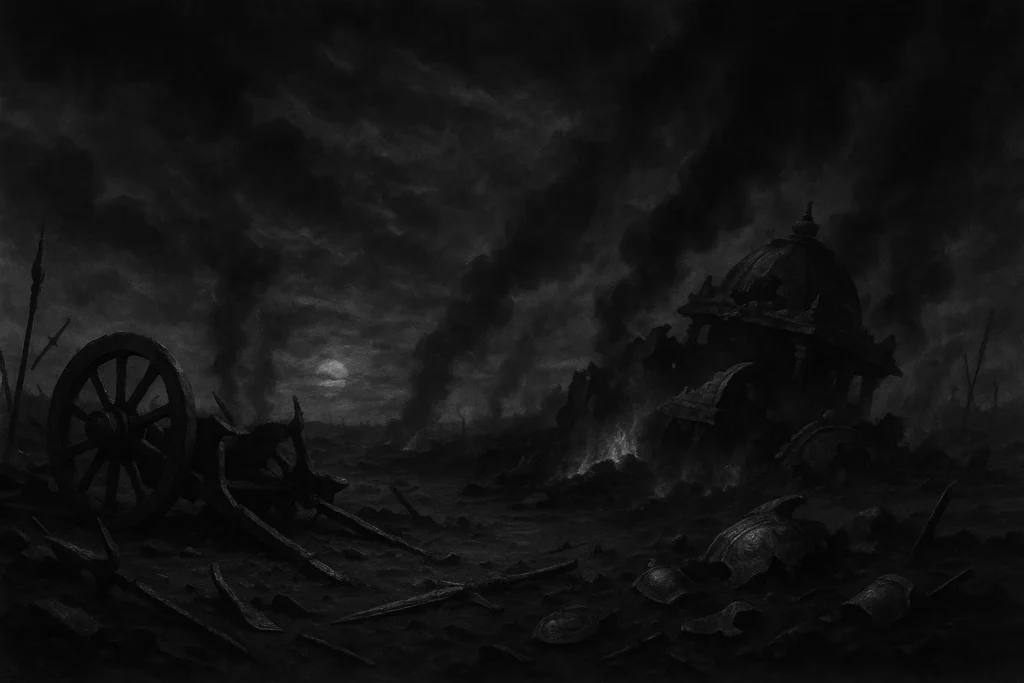
Asura-Deva Conflicts
Ravana’s role in the cosmic struggle between Asuras and Devas is central to his narrative, epitomized by his rivalry with Rama, Vishnu’s avatar, in the Ramayana. His most infamous act—abducting Sita to provoke Rama—ignites a war that defines the epic’s exploration of dharma. Ravana’s ambition to dominate the heavens leads to earlier conflicts with Devas, such as his challenge to Indra and his conquest of Kailasa, where he lifts Shiva’s mountain, only to be humbled by the god’s toe. These battles show his near-invincibility—granted by Brahma’s boon—which protects him from gods and demons but not humans or monkeys (a loophole exploited by Rama).
The war in Lanka, where Ravana faces Rama’s army of Vanaras led by Hanuman, underscores the stakes of the Asura-Deva conflict. Ravana’s strategic brilliance and magical prowess make him a formidable foe, but his pride blinds him to Vibhishana’s defection and Rama’s divine power. This struggle reflects the triumph of dharma over adharma, with Ravana’s defeat restoring cosmic balance. His conflicts, blending martial skill and hubris, highlight the eternal tension between divine order and demonic ambition in Hindu mythology.
Role in Hindu Cosmology
In Hindu cosmology, Ravana embodies the interplay of dharma, ambition, and redemption. As Lanka’s king, he represents adharma through his defiance of divine order, yet his devotion to Shiva reveals a complex anti-hero. His actions (such as abducting Sita) disrupt the cosmic balance, prompting Vishnu’s intervention as Rama.
In the Ramayana, Ravana’s defeat restores dharma, illustrating the cycle of creation, destruction, and renewal central to Hindu thought. His role as a devotee, seen in his composition of the Shiva Tandava Stotra, suggests a path to redemption, as his soul, purified by Rama’s arrow, is believed to ascend spiritually.
Ravana’s influence extends to human affairs, as his story serves as a cautionary warning against the dangers of pride and unchecked desire.
In some traditions, his scholarly achievements and devotion inspire reverence, positioning him as a cautionary yet admirable figure. His defeat underscores the inevitability of divine justice, reinforcing the Hindu belief in karma and rebirth, where even a mighty Asura faces consequences for defying cosmic law.
Biography
Ravana, the mighty Rakshasa king of Lanka, is a central figure in the Ramayana, known for his ten heads, scholarly brilliance, and tragic pride. Born to the sage Vishrava and Rakshasi Kaikesi, he rose from a divine-demonic lineage to become a formidable ruler, scholar, and devotee of Shiva.
His life, marked by conquests, devotion, and the infamous abduction of Sita, showcases a complex blend of power, intellect, and hubris. From his early education in the Vedas to his reign over Lanka’s golden empire, his whole life reflects his ambition to challenge the heavens, culminating in his epic clash with Rama, Vishnu’s avatar, which seals his fate.
| Attribute | Details |
|---|---|
| Parents | Vishrava, Kaikesi |
| Siblings | Kubera, Vibhishana, Kumbhakarna, Surpanakha |
| Spouse | Mandodari, others |
| Children | Meghanada, Atikaya, Akshayakumara, Narantaka, Devantaka, Trishira |
Birth
Ravana was born in the Treta Yuga to Vishrava, a revered Brahmin sage, and Kaikesi, a Rakshasa princess, blending divine and demonic heritage. Some traditions, particularly in Bisrakh, Uttar Pradesh, claim his birthplace was named after his father, Vishrava.
His paternal grandfather, Pulastya, was one of the Saptarishis (seven great sages) and a mind-born son of Brahma, tying Ravana to a prestigious lineage. His maternal grandfather, Sumali, a powerful Rakshasa king, sought an exceptional heir by arranging Kaikesi’s marriage to Vishrava, rejecting mortal kings as unworthy of such a union.
Ravana and his siblings—Kubera, Vibhishana, Kumbhakarna, and Surpanakha—were raised under their father’s tutelage. Ravana excelled in Vedic studies, mastering scriptures and rituals, which shaped his intellectual prowess and set the foundation for his later achievements as a scholar and warrior.
Family
Ravana’s family ties reflect his dual nature as both the son of a sage and a Rakshasa leader.
His parents, Vishrava (son of Pulastya) and Kaikesi (daughter of Sumali and Ketumati), connected him to divine and demonic realms. He had seventeen maternal uncles, including Dhumraksha, Prahastha, Akampana, and Virupaksha, who served as generals in Lanka’s army.
Other relatives, such as Khara and Dushana, governed territories like Janasthana, thereby strengthening Ravana’s rule. His maternal grandfather, Sumali, and granduncle, Malyavan, played key roles in his rise, urging him to seek Brahma’s boons and seize Lanka from his half-brother Kubera.
However, Malyavan later opposed Ravana’s war with Rama, highlighting family tensions. Another granduncle, Mali, was slain by Vishnu, foreshadowing Ravana’s own fate.
Ravana had over a thousand wives, with Mandodari, daughter of the celestial architect Maya, as his chief queen, admired for her wisdom and loyalty.
His sons—Meghanada (also called Indrajit), Atikaya, Akshayakumara, Narantaka, Devantaka, and Trishira—were fierce warriors, with Meghanada nearly rivaling his father’s prowess.
His siblings included Kubera, whom he overthrew; Vibhishana, who defected to Rama; Kumbhakarna, a loyal giant; and Surpanakha, whose encounter with Rama triggered the Ramayana’s central conflict.
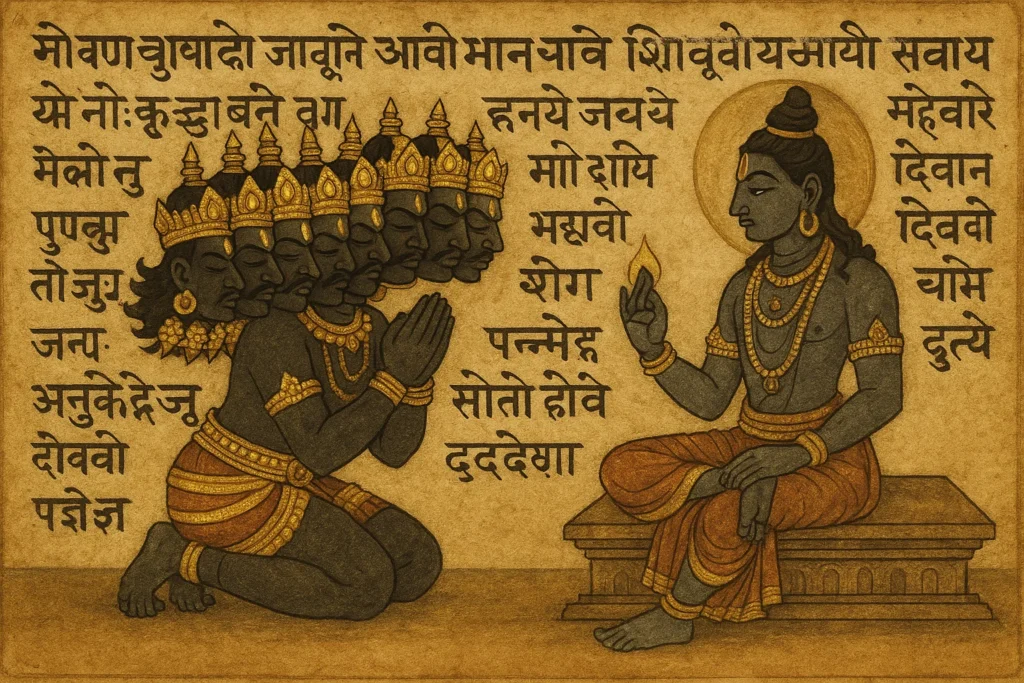
Was Ravana Ever Mentioned in Vedic Texts?
Ravana does not appear in early Vedic texts. His character likely originates in the epic and Puranic traditions, particularly in Valmiki’s Ramayana and the Vishnu Purana.
The Vedas focus on Devas like Indra battling generic Asuras, such as Vritra, but lack specific references to Ravana.
Ravana in Epics and Puranas
Ravana is a central figure in Valmiki’s Ramayana, where he is the antagonist who abducts Sita, sparking Rama’s quest. Authored around the 5th century BCE, the Ramayana portrays him as a learned but prideful king, wielding the Chandrahasa sword and ruling Lanka with unmatched power.
In the Vishnu Purana, he is depicted as a devotee of Shiva, earning boons through intense penance.
The Shiva Purana highlights his musical skill, crediting him with composing the Shiva Tandava Stotra.
In Tamil’s Kamba Ramayanam, he is a tragic figure, admired for his intellect yet doomed by hubris.
| Source | Quote |
|---|---|
| Ramayana, Aranya Kanda | “Ravana, the king of Rakshasas, carried away Sita, the wife of Rama.” |
| Vishnu Purana | “Ravana, having propitiated Brahma, obtained boons of invincibility.” |
| Shiva Purana | “Ravana, with devotion, composed hymns to Shiva, pleasing the Lord.” |
Powers and Abilities
Ravana is a near-invincible Asura, limited only by his pride and specific vulnerabilities. His abilities include:
- Near-Invincibility: A boon from Brahma protects him from gods, demons, and spirits, but not humans or monkeys, as exploited by Rama and Hanuman.
- Shape-Shifting: He transforms into a hermit to abduct Sita, showcasing his deceptive prowess (Ramayana, Aranya Kanda).
- Magical Mastery: Skilled in Tantric and Vedic rituals, he summons illusions and weapons like the Shakti spear in battle.
- Superhuman Strength: He lifts Kailasa mountain (Shiva Purana), overpowering Devas like Kubera.
- Intellectual Brilliance: A master of the Vedas and Shastras, he composes the Shiva Tandava Stotra and excels in strategy.
- Aerial Combat: Commands the Pushpaka Vimana, a flying chariot, for swift conquests.
- Musical Talent: Plays the veena with divine skill, pleasing Shiva during penance.
Ravana Myths, Legends, and Stories
The Abduction of Sita in the Ramayana
In Valmiki’s Ramayana (Aranya Kanda), Ravana, enamored by Sita’s beauty, devises a plan to abduct her. He sends his ally Maricha to lure Rama and Lakshmana away from their forest hermitage by transforming into a golden deer.
Sita, captivated by the deer, urges Rama to pursue it. As Rama chases the deer and Lakshmana follows, Ravana seizes his chance. Disguised as a hermit, he approaches Sita, revealing his true form when she refuses his advances. He abducts her in his Pushpaka Vimana, flying to Lanka. Sita’s cries alert Jatayu, a vulture, who battles Ravana but is mortally wounded.
This act sparks Rama’s alliance with Sugriva and Hanuman, leading to the epic war. Ravana’s lust and pride drive this pivotal narrative, setting the stage for his downfall.
The Penance to Shiva in the Shiva Purana
The Shiva Purana recounts Ravana’s intense devotion to Shiva. Seeking power, he performs severe penance in the Himalayas, chanting hymns and playing the veena. Pleased, Shiva grants him the Chandrahasa sword and blessings, strengthening his rule.
In another tale, Ravana attempts to lift Kailasa, Shiva’s abode, to prove his might. The mountain trembles, alarming Parvati, but Shiva presses it down with his toe, trapping Ravana. Humbled, he sings the Shiva Tandava Stotra, earning Shiva’s forgiveness and further boons.
The Boon from Brahma in the Vishnu Purana
In the Vishnu Purana, Ravana undertakes rigorous penance to appease Brahma. After years of austerity, Brahma appears, offering a boon. Ravana requests invincibility against gods, demons, and spirits, which Brahma grants, but he omits humans and monkeys, deeming them insignificant.
This boon fuels Ravana’s conquests, enabling him to defeat Indra and seize Lanka from Kubera. However, his arrogance leads him to underestimate Rama, a human, fulfilling the boon’s loophole.
You may also enjoy:
Who Are the Yaksha, and Why Did Buddhists Fear Their Wrath?
October 20, 2025
Who Was Hiranyakashipu, the Demon King of Hindu Mythology?
October 6, 2025
Who Is Aka Manto, Japan’s Terrifying Red-Cloaked Yōkai?
October 24, 2025
Who Is Taṇhā, the Seductive Demon of Craving in Buddhist Mythology?
October 15, 2025
Who Is Adrammelech in Demonology and the Bible?
October 1, 2025
Who Was Ravana in Hindu Mythology and Why Was He Feared?
October 3, 2025
Ravana vs Other Asuras
| Asura Name | Associated Trait/Role | Clan/Origin | Key Traits/Powers |
|---|---|---|---|
| Hiranyakashipu | Devotion, Tyranny | Daitya, Narasimha | Boons, illusion |
| Hiranyaksha | Conquest | Daitya, Varaha | Strength, earth-lifting |
| Bali | Generosity | Daitya, Vamana | Charity, strength |
| Vritra | Obstruction | Asura, Rig Veda | Drought, serpent form |
| Mahishasura | Deception | Asura, Devi Mahatmya | Shape-shifting, buffalo form |
| Tarakasura | War | Asura, Skanda Purana | Invincibility, combat |
| Banasura | Loyalty | Asura, Shiva Purana | Thousand arms, devotion |
| Narakasura | Oppression | Asura, Bhagavata Purana | Darkness, conquest |
| Andhaka | Blindness | Asura, Shiva Purana | Regeneration, combat |
| Shumbha | Leadership | Asura, Devi Mahatmya | Strategy, war |
| Nishumbha | Support | Asura, Devi Mahatmya | Combat, loyalty |
| Raktabija | Multiplication | Asura, Devi Mahatmya | Blood replication |
| Kumbhakarna | Slumber | Rakshasa, Ramayana | Giant size, strength |
| Vibhishana | Righteousness | Rakshasa, Ramayana | Wisdom, devotion |
Rank Among Asuras
Ravana holds a preeminent rank among Asuras as the king of Lanka and leader of the Rakshasas. His authority surpasses most Daityas and Danavas, as seen in his conquest of Kubera’s city and his challenge to Indra.
In the Ramayana, he commands a vast army of Rakshasas, including his brother Kumbhakarna and son Indrajit, showcasing his dominance. His relationship with Vibhishana, who defects to Rama, highlights internal rivalries, while his alliance with Maricha reflects his strategic manipulation of other Asuras.
Unlike Hiranyakashipu or Tarakasura, who rely solely on boons, Ravana’s blend of martial skill, intellect, and devotion to Shiva elevates his status. His rivalry with Devas, particularly Rama and Indra, underscores his ambition to overthrow divine order, positioning him as a central figure in Asura-Deva conflicts.
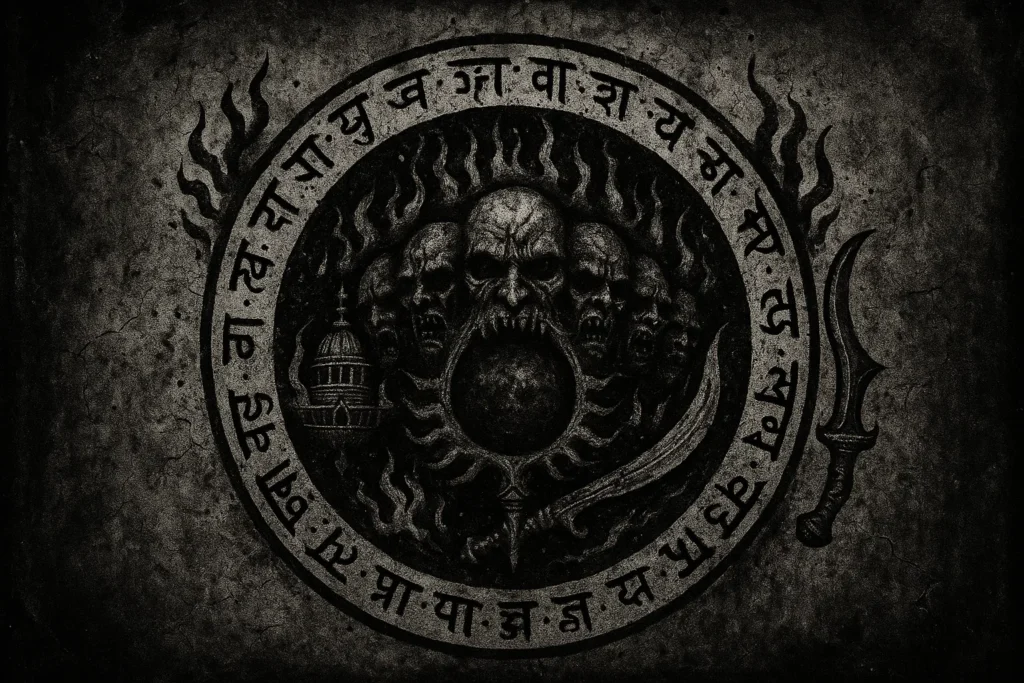
Mystical Correspondences
| Attribute | Details |
|---|---|
| Planet | Mars |
| Zodiac Sign | Aries |
| Element | Fire |
| Direction | East |
| Color | Red, Gold |
| Number | 10 |
| Crystal/Mineral | Ruby |
| Metal | Gold |
| Herb/Plant | Red Sandalwood |
| Animal | Elephant |
| Trait/Role | Conquest, Devotion |
Ravana’s cosmic ties anchor his power in the heavens, with Mars as his ruling planet, embodying war and ambition. This planetary influence drives his conquests, as seen in his battles against Indra and Kubera, with rituals invoking his strength often timed to coincide with Mars’s peak, such as Tuesdays or the Aries season (March 21–April 19).
His zodiac sign, Aries, channels fiery determination, fueling his relentless pursuit of dominance over Lanka. This celestial alignment enhances his martial prowess, as noted in the Ramayana, where his chariot appears to blaze across the skies.
The fire element defines Ravana’s destructive and intellectual might, reflected in his fiery rage and mastery of magic. In Vedic cosmology, fire is tied to the east, the direction of conquest, where Lanka’s golden spires shine.
His ten heads, linked to the number 10, symbolize his vast intellect, while ruby and gold reflect his regal power.
Red sandalwood is used in Shiva rituals honoring him, and the elephant, a symbol of strength, mirrors his commanding presence.
Ravana’s Symbols and Iconography
Ravana’s symbols reflect his power and complexity. His Chandrahasa sword, granted by Shiva, symbolizes his martial prowess and divine favor, often depicted in temple art.
The Pushpaka Vimana, a flying chariot, represents his dominion over the skies. In iconography, his ten heads and twenty arms dominate, carved in South Indian temples, such as those in Ellora, showcasing his intellect and strength.
Yantras dedicated to Shiva, used in Tantric worship, sometimes feature Ravana. His golden crown and red-gold attire in art highlight his royal and fiery nature.
Worship and Boons
Ravana’s worship, rooted in his devotion to Shiva, involves intense tapasya (penance).
In the Shiva Purana, he meditates for years, offering his head to Shiva’s fire, earning the Chandrahasa sword and blessings. His boon from Brahma in the Vishnu Purana grants near-invincibility, except against humans and monkeys.
In some Tantric traditions, devotees invoke Ravana for strength and knowledge, using red sandalwood and ruby-studded offerings on Tuesdays.
Rituals include chanting the Shiva Tandava Stotra and fire altars, aligning with his fiery element. His boons, while empowering, underscore his tragic flaw—pride—leading to his downfall.
You may also enjoy:
Vaisravana: The Golden Guardian King Who Rules the North
October 16, 2025
What Is Qarin and Why Does It Follow Every Human Being?
October 8, 2025
Bali: The Benevolent Asura King of Hindu Mythology
October 10, 2025
The Ghul: The Flesh-Eating Demon of Arabian Folklore
October 1, 2025
Marid: The Ocean Jinn That Defies Heaven and Earth
September 30, 2025
Rāga: The Seductive Demon of Passion and Desire in Buddhist Lore
October 16, 2025
